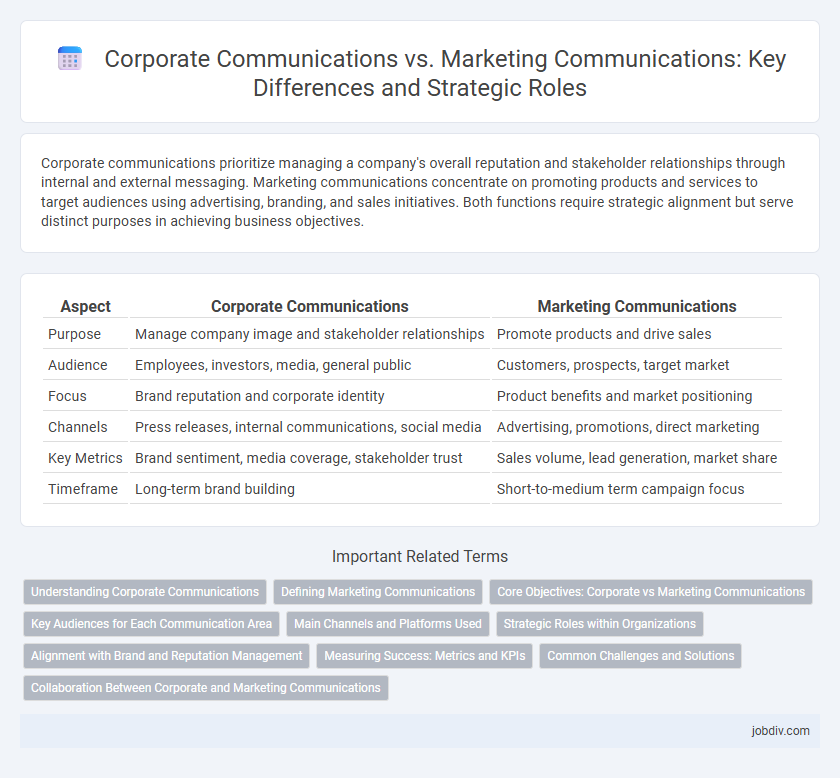Corporate communications prioritize managing a company's overall reputation and stakeholder relationships through internal and external messaging. Marketing communications concentrate on promoting products and services to target audiences using advertising, branding, and sales initiatives. Both functions require strategic alignment but serve distinct purposes in achieving business objectives.
Table of Comparison
| Aspect | Corporate Communications | Marketing Communications |
|---|---|---|
| Purpose | Manage company image and stakeholder relationships | Promote products and drive sales |
| Audience | Employees, investors, media, general public | Customers, prospects, target market |
| Focus | Brand reputation and corporate identity | Product benefits and market positioning |
| Channels | Press releases, internal communications, social media | Advertising, promotions, direct marketing |
| Key Metrics | Brand sentiment, media coverage, stakeholder trust | Sales volume, lead generation, market share |
| Timeframe | Long-term brand building | Short-to-medium term campaign focus |
Understanding Corporate Communications
Corporate communications encompasses the strategic management of a company's internal and external messaging to build and maintain a positive reputation with stakeholders, including employees, investors, and the public. It involves handling investor relations, crisis communication, corporate social responsibility, and executive communication to align the organization's values and goals. Understanding corporate communications is essential for fostering trust, enhancing brand credibility, and supporting overall business objectives.
Defining Marketing Communications
Marketing Communications encompasses strategic messaging designed to promote products or services, targeting specific customer segments to drive sales and brand awareness. It integrates advertising, public relations, digital content, and social media campaigns to deliver compelling value propositions. This discipline prioritizes measurable engagement and conversion metrics, distinguishing itself from broader Corporate Communications focused on overall reputation management.
Core Objectives: Corporate vs Marketing Communications
Corporate communications primarily focus on building and maintaining a positive corporate image, managing stakeholder relationships, and ensuring consistent messaging across all internal and external channels. Marketing communications concentrate on promoting products or services, driving customer engagement, and increasing sales through targeted campaigns and brand positioning. Both disciplines use strategic messaging but differ in their core objectives: corporate communications prioritize reputation and trust, while marketing communications emphasize market demand and customer conversion.
Key Audiences for Each Communication Area
Corporate Communications primarily targets internal stakeholders, including employees, management, investors, and regulatory bodies, ensuring transparent and consistent messaging about company values, policies, and financial performance. Marketing Communications focuses on external audiences such as customers, prospects, partners, and the media, aiming to drive brand awareness, product engagement, and sales. Understanding these distinct key audiences helps organizations tailor their strategies to effectively build trust internally while promoting value externally.
Main Channels and Platforms Used
Corporate communications primarily utilize internal channels such as intranet, email newsletters, and town hall meetings to engage employees, shareholders, and stakeholders with organizational updates and reputation management. Marketing communications focus on external platforms including social media, digital advertising, content marketing, and events to target customers and drive brand awareness and sales. Both disciplines leverage multimedia tools but differ in purpose, audience, and specific channel selection for effective messaging.
Strategic Roles within Organizations
Corporate communications concentrate on managing an organization's overall reputation, internal culture, and stakeholder relationships through strategic messaging and crisis management. Marketing communications specifically target customer engagement, brand positioning, and product promotion to drive sales and market growth. Both functions align closely with the organization's strategic objectives but differ in audience focus and communication goals.
Alignment with Brand and Reputation Management
Corporate communications focuses on maintaining a consistent brand image and protecting reputation across all stakeholder interactions, emphasizing transparency and trust-building. Marketing communications drives brand awareness and customer engagement through targeted promotional messages that align with corporate values and identity. Coordinated efforts between both functions ensure unified messaging, enhancing overall brand equity and sustaining positive reputation management.
Measuring Success: Metrics and KPIs
Corporate communications success is measured through metrics such as brand reputation scores, employee engagement rates, and media sentiment analysis, which reflect internal alignment and public perception. Marketing communications focus on KPIs like conversion rates, customer acquisition costs, and return on investment (ROI) to evaluate campaign effectiveness and revenue impact. Both disciplines rely on analytics tools but prioritize different indicators aligned with their strategic objectives.
Common Challenges and Solutions
Corporate communications and marketing communications both face challenges in message consistency and audience engagement. Misalignment between internal corporate messaging and external marketing campaigns can create brand confusion, requiring integrated communication strategies and collaborative content planning. Employing unified communication platforms and regular cross-departmental meetings enhances coherence and addresses stakeholder expectations effectively.
Collaboration Between Corporate and Marketing Communications
Effective collaboration between Corporate Communications and Marketing Communications enhances brand consistency and strengthens organizational messaging across all platforms. Corporate Communications ensures alignment with the company's mission and values, while Marketing Communications focuses on targeted campaigns and customer engagement. Integrating these functions drives unified storytelling, boosts stakeholder trust, and maximizes impact in both internal and external communications.
Corporate Communications vs Marketing Communications Infographic

 jobdiv.com
jobdiv.com